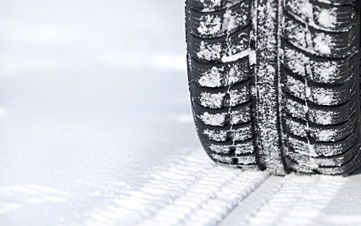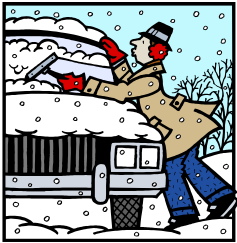Climate changes don’t affect just you―they also affect your vehicle. In regions that don’t enjoy mild winters, you wouldn’t dream of heading outside without a heavy coat if the wind chill brought the temperature below freezing. Don’t expect your car to function properly without some attention to its winter needs, too.
Engine Oil in the Winter
The oil in your engine changes depending on how hot or cold the engine is running. Because the outside temperatures will influence the internal temperature of your engine, you need to make sure you’re using the proper oil for the conditions.
During the winter months, if you live where temperatures get below freezing, you’ll want to switch over to thinner―less viscous―oil. If you run a 10W-30 in the summer, for example, try moving to a 5W-30 when changing your oil in the fall or winter. If you are in doubt, refer to your manual or the manufacturer.
Engine Coolant
You vehicle’s coolant system is not intended only to keep your engine from overheating. It is also responsible for protecting your valuable engine against corrosion. Before the weather gets too cold, make sure you are using coolant with ethylene glycol to help protect your engine.
Every vehicle requires a certain ratio of coolant to water, and your owner’s manual or repair technician can explain what your engine needs. For most vehicles, a winter ratio is 60% coolant to 40% water. Adjusting this ratio is an important step in winterizing your vehicle, so if you need help, ask someone who is experienced and knowledgeable.
Cold Weather and Battery Capacity
It isn’t only your engine that doesn’t like to start in the winter. Your battery capacity is reduced by the cold weather, too. A thorough inspection of your battery, cables, terminals, and fluid will help you make sure your vehicle is ready for the winter.
Check over the battery cables for cracks and breaks. The terminals should fit snugly with no loose connections. You can check your battery fluid by uncovering the refill hole (or sometimes holes). If the level is below the bottom of the cap, refill with distilled water.
To read the level of charge in your battery, you will need to turn the engine off. Some batteries have a built-in hydrometer eye that tells you the amount of voltage remaining in the battery. If you prefer, a handheld hydrometer can be used to collect the same information.
While you’re inspecting your battery, look around for the manufacture date. Knowing how old your battery is can clue you in to when it will begin to lose charge. Shopping for a new battery? Never buy one with a six-month-old manufacture date.
Snow Tires
When it comes to really dealing with winter weather, your tires are out there mixing with the snow, sleet, and ice. Driving in snow can be very difficult and sometimes dangerous; still, the reality is you need to get to work.
Mounting the right tires on your car or truck can give you a huge advantage when trekking through snow. Many vehicle makers and tire manufacturers recommend changing all four tires to snow tires in the winter. If you don’t swap all four, the difference between snow and summer tires can cause other problems for your vehicle.
If you live off the beaten path, you can even buy snow tires with studs to help you get where you’re going all winter long. When spring comes, though, you’ll be glad to get out of the heavy winter tires because your fuel efficiency and handling will improve with a less aggressive tire.
Another option is all-season tires that you drive year-round―winter and summer. The advantage of all-season tires is that you don’t change the tires before winter or need to keep two sets of rims. Of course, the disadvantage is that you don’t get all the great features of a specialized seasonal tire.
Windshield Treatment
An easily overlooked part of your winterizing program is your windshield. If you have ever driven behind another vehicle kicking up wet, dirty road snow, then you already have a true appreciation for windshield washer fluid.
For best results in clearing off cold, heavy grime, select a washer fluid with an antifreeze solution. But beware―some washer fluids can be harsh and damage your vehicle’s paint.
Frozen Out
Door locks can freeze in cold weather and break your key if you try to force them open. The old fashion cure was warm water, but what if you’re not at home and don’t have any warm water nearby? Discount stores, auto parts stores, and even hardware stores sell glycerine you can use for de-icing. Think about where you keep it, however, because if the de-icer is in the glove box of your frozen-shut vehicle, then it won’t help you any.
Stock a tube at home in the garage and also in your desk at work. That way whenever your locks freeze up, you’ll be able to solve the problem.
Emergency Kit
If you don’t already have an emergency kit in your vehicle, consider putting together a few basics and stowing them in the trunk. Naturally, you’ll want to be sure your spare tire is in good shape with all the tools to change it out. But you might also want a few other emergency items in case you slide off the road and get stuck in a snow bank:
- Flares
- Blankets
- Boots
- Radio
- Engine oil
- Washer fluid
- Coolant
- Flashlight
When you take the time to winterize your vehicle, you become more comfortable driving in cold, snowy climates. A short commute quickly becomes difficult when your vehicle isn’t equipped to handle snow and ice. By planning ahead, you can make winterizing your vehicle an annual ritual in the name of safety and vehicle reliability.


